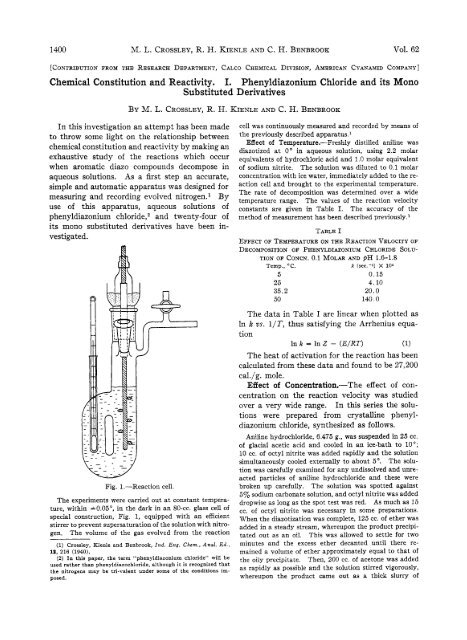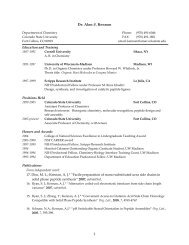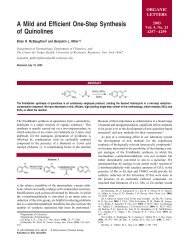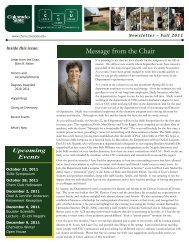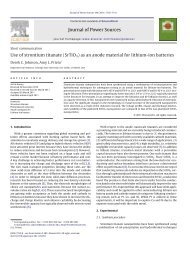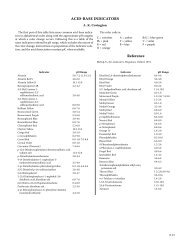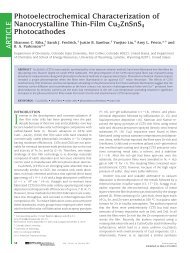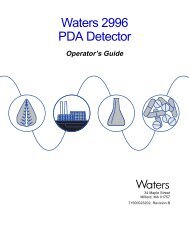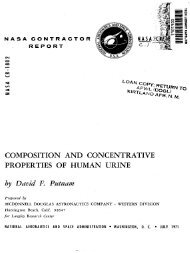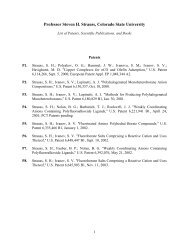Chemical Constitution and Reactivity. I. Phenyldiazonium Chloride ...
Chemical Constitution and Reactivity. I. Phenyldiazonium Chloride ...
Chemical Constitution and Reactivity. I. Phenyldiazonium Chloride ...
Create successful ePaper yourself
Turn your PDF publications into a flip-book with our unique Google optimized e-Paper software.
1400 M. L. CROSSLEY, R. H. KIENLE AND C. H. BENBROOK Vol. 62<br />
[CONTRIBUTION FROM THE RESEARCH DEPARTMENT, CALCO CHEMICAL DIVISION, AMERICAN CYANAMID COMPANY ]<br />
<strong>Chemical</strong> <strong>Constitution</strong> <strong>and</strong> <strong>Reactivity</strong>. I. <strong>Phenyldiazonium</strong> <strong>Chloride</strong> <strong>and</strong> its Mono<br />
Substituted Derivatives<br />
BY M. L. CROSSLEY, R. H. KIENLE AND C. H. BENBROOK<br />
In this investigation an attempt has been made<br />
to throw some light on the relationship between<br />
chemical constitution <strong>and</strong> reactivity by making an<br />
exhaustive study of the reactions which occur<br />
when aromatic diazo compounds decompose in<br />
aqueous solutions. As a first step an accurate,<br />
simple <strong>and</strong> automatic apparatus was designed for<br />
measuring <strong>and</strong> recording evolved nitrogen. By<br />
use of this apparatus, aqueous solutions of<br />
phenyldiazonium chloridej2 <strong>and</strong> twenty-four of<br />
its mono substituted derivatives have been in-<br />
vestigated.<br />
w<br />
Fig. 1.-Reaction cell.<br />
The experiments were carried out at constant tempera-<br />
ture, within *0.05', in the dark in an 80-cc. glass cell of<br />
special construction, Fig. 1, equipped with an efficient<br />
stirrer to prevent supersaturation of the solution with nitro-<br />
gen. The volume of the gas evolved from the reaction<br />
(1) Crossley, Kienle <strong>and</strong> Benbrook, Ind. Eng. Chcm., Anal. Ed.,<br />
12, 216 (1940).<br />
(2) In this paper, the term "phenyldiazonium chloride" will be<br />
used rather than phenyldiazochloride, although it is recognized that<br />
the nitrogens may be tri-valent under some of the conditions im-<br />
posed.<br />
cell was continuously measured <strong>and</strong> recorded by means of<br />
the previously described apparatus.<br />
Effect of Temperature.-Freshly distilled aniline was<br />
diazotized at 0' in aqueous solution, using 2.2 molar<br />
equivalents of hydrochloric acid <strong>and</strong> 1.0 molar equivalent<br />
of sodium nitrite. The solution was diluted to 0.1 molar<br />
concentration with ice water, immediately added to the re-<br />
action cell <strong>and</strong> brought to the experimental temperature.<br />
The rate of decomposition was determined over a wide<br />
temperature range. The values of the reaction velocity<br />
constants are given in Table I. The accuracy of the<br />
method of measurement has been described previously.'<br />
TABLE I<br />
EFFECT OF TEMPERATURE ON THE REACTION VELOCITY OF<br />
DECOMPOSITION OF PHENYLDIAZONIUM CHLORIDE SOLU-<br />
TION OF CONCN. 0.1 MOLAR AND pH 1.G1.8<br />
Temp., OC. k (sec.-1) X lo5<br />
5 0.15<br />
25 4.10<br />
35.2 20.0<br />
50 140.0<br />
The data in Table I are linear when plotted as<br />
In k vs. 1/T, thus satisfying the Arrhenius equation<br />
Ink = In 2 - (E/RT)<br />
(1)<br />
The heat of activation for the reaction has been<br />
calculated from these data <strong>and</strong> found to be 27,200<br />
cal./g. mole.<br />
Effect of Concentration.-The effect of concentration<br />
on the reaction velocity was studied<br />
over a very wide range. In this series the solutions<br />
were prepared from crystalline phenyldiazonium<br />
chloride, synthesized as follows.<br />
Aniline hydrochloride, 6.475 g., was suspended in 25 cc.<br />
of glacial acetic acid <strong>and</strong> cooled in an ice-bath to 10";<br />
10 cc. of octyl nitrite was added rapidly <strong>and</strong> the solution<br />
simultaneously cooled externally to about 5". The solu-<br />
tion was carefully examined for any undissolved <strong>and</strong> unre-<br />
acted particles of aniline hydrochloride <strong>and</strong> these were<br />
broken up carefully, The solution was spotted against<br />
5% sodium carbonate solution, <strong>and</strong> octyl nitrite was added<br />
dropwise as long as the spot test was red. As much as 15<br />
cc. of octyl nitrite was necessary in some preparations.<br />
When the diazotization was complete, 125 cc. of ether was<br />
added in a steady stream, whereupon the product precipi-<br />
tated out as an oil. This was allowed to settle for two<br />
minutes <strong>and</strong> the excess ether decanted until there re-<br />
mained a volume of ether approximately equal to that of<br />
the oily precipitate. Then, 200 cc. of acetone was added<br />
as rapidly as possible <strong>and</strong> the solution stirred vigorously,<br />
whereupon the product came out as a thick slurry of
June, 1940 DECOMPOSITION OF PHENYLDIAZONIUM CHLORIDES 1401<br />
coarse crystals. The product was filtered, washed by re-<br />
suspension twice in acetone <strong>and</strong> twice in ether. It was<br />
dried in air until free of ether <strong>and</strong> then in a desiccator until<br />
free of moisture. The yield was 3.5 g. All reasonable<br />
safety precautions were taken because of the highly ex-<br />
plosive nature of the product.<br />
The product was stored in a desiccator. In the dry<br />
state, no measurable decomposition occurred. The evolved<br />
nitrogen per gram remained constant. Each aliquot was<br />
weighed out <strong>and</strong> dissolved immediately prior to use.<br />
In order to justify the comparison of data ob-<br />
tained by use of crystalline diazonium chloride<br />
with those obtained by use of diazonium chloride<br />
solutions prepared by direct diazotization, two<br />
decomposition experiments, identical except as<br />
regards the method of preparation, were run. No<br />
difference in the rate data was found.<br />
Separate experiments were carried out at con-<br />
centrations ranging from a water-diazo ratio of<br />
1280:l (moles) to an extremely concentrated<br />
solution wherein the ratio was 2.36:l (moles).<br />
It was observed that for all concentration ratios<br />
the reaction followed the first order law. Data<br />
TABLE 11<br />
EFFECT OF CONCENTRATION ON THE REACTION VELOCITY<br />
CONSTANT AND YIELD OF PHENOL IN DECOMPOSITION OF<br />
PHENYLDIAZONIUM CHLORIDE SOLUTIONS, TEMP. 35 '<br />
Moles HrO/moles<br />
diazo k (sec-1) X IO5<br />
'% yield of<br />
phenol<br />
2.36 26.2 24.3<br />
3.11 26.8 30.0<br />
3.54 25.6 27.1<br />
3.94<br />
7.93<br />
26.7<br />
..<br />
31.4<br />
37.0<br />
11.89 25.3 40.0<br />
23.80 24.5 48.7<br />
31.70 23.9 58.5<br />
47.58 23.4 59.3<br />
79.30 21.9 78.0<br />
158.60<br />
317.20<br />
634.40<br />
21.2<br />
..<br />
..<br />
88.0<br />
90.8<br />
94.6<br />
1268.00 19.2 95.2<br />
formation of monochlorobenzene has been ob-<br />
served by Hantz~ch.~<br />
Deuterium Oxide as Solvent.-Two runs were<br />
made under identical conditions except that in the<br />
molecular treatments of the most<br />
concentrated solution investigated 8<br />
illustrate this point (Fig. 2). The<br />
reaction, therefore, appears to be e 6<br />
truly monomolecular.<br />
-7<br />
The principal reaction products in<br />
the decomposition of phenyldiazo-<br />
4<br />
-9<br />
nium chloride in water are usually +I 2<br />
considered to be phenol, nitrogen<br />
-11<br />
<strong>and</strong> hydrochloric acid. By analysis<br />
of the residues in the concentration<br />
0<br />
- 13<br />
0 2 4<br />
however, that the percentage yield<br />
Hours. Hours.<br />
of phenol is a function of the<br />
Fig. 2.-Comparison<br />
tion. In the most concentrated exof<br />
unimolecular <strong>and</strong> bimolecular plots.<br />
diazo to water 1:2.36 moles.<br />
Ratio of<br />
periments carried out, where the water-diazo ratio first run the diazonium chloride was dissolved in<br />
was 2.36:l (moles), the percentage yield of phenol water, whereas in the second run the solvent was<br />
was 24.3%. On the other h<strong>and</strong>, in the most dilute deuterium oxide. The reaction velocity conexperiment,<br />
the corresponding yield of phenol was stants were essentially the same, i. e., 0.00025<br />
95.2%.<br />
sec.-l <strong>and</strong> 0.00024 set.-', respectively.<br />
The reaction velocity constants <strong>and</strong> phenol Effect of fiH on the Reaction.-A series of exyield<br />
obtained for the various concentrations periments was run in which phenyldiazonium<br />
studied are given in Table 11.<br />
chloride was dissolved in different strengths of<br />
An attempt was made to determine qualita- concentrated hydrochloric acid. In changing<br />
tively what products other than phenol are pres- the normality of the hydrochloric acid from 0.1<br />
ent after decomposition has occurred. In the to 12 N, only a slight change in the value of the<br />
concentrated solutions monochlorobenzene, ben- reaction velocity constant is noticed (see Table<br />
zene, <strong>and</strong> biphenyl were identified, monochlorobenzene<br />
appearing in greatest quantity. The<br />
111). It is interesting to note that the change in<br />
(3) Hantzsch, Ber., 88, 2534 (1900).
1402 M. L. CROSSLEY, R. H. KIENLE AND C. H. BENBROOK Vol. 62<br />
reaction velocity is small even though Hantzsch3<br />
has found that in concentrated hydrochloric acid<br />
solution the yield of monochlorobenzene increases<br />
to 60%.<br />
TABLE I11<br />
EFFECT OF ACID CONCENTRATION ON THE REACTION<br />
VELOCITY CONSTANT IN DECOMPOSITION OF PHENYL-<br />
DIAZONIUM CHLORIDE SOLUTION, 0.1 MOLAR, TEMP. 35'<br />
HC1 concn., A' k (sec-1) X 106<br />
0.1 20.0<br />
5.0 23.5<br />
10.0 24.1<br />
12.0 22.6<br />
Several solutions of phenyldiazonium chloride<br />
were brought to different PH values by the addi-<br />
tion of sodium hydroxide solution. Each sample<br />
was held at a temperature of 35'. When the pH<br />
was brought to a value of 11.2 (Fig. 3), it dropped<br />
within a period of forty minutes to a PH of 2.<br />
r-- I<br />
13 I<br />
1 I I I I I I I<br />
0 20 40 100<br />
Minutes .<br />
Fig. 3.+H vs. time plot, phenyl diazo chloride solution,<br />
T = 35", concn. = 0.1 molar.<br />
However, when the original pH was 11.6 or more,<br />
the pH value remained above 10. This series was<br />
followed by another in which buffered samples<br />
were studied at various PH's to cover the range<br />
3 to 11.8. The data obtained showing the per-<br />
centage nitrogen evolved, together with the pH<br />
changes which occur in spite of the buffering, are<br />
given in Fig. 4.<br />
Mono-substituted Derivatives of Phenyldi-<br />
azonium <strong>Chloride</strong>.-A temperature study was<br />
made on the ortho, meta, <strong>and</strong> para methyl,<br />
methoxy, phenyl, hydroxy, chloro, carboxy, sulfo,<br />
<strong>and</strong> nitro phenyldiazonium chlorides. The amines<br />
from which the diazonium salts were prepared<br />
were Eastman Kodak Co. c. P. chemicals, except<br />
for m-aminobiphenyl, which was synthesized by<br />
the method of Fichter <strong>and</strong> S~lzberger.~ The<br />
Eastman samples were further purified in our<br />
laboratory.<br />
90<br />
70<br />
3<br />
5 50<br />
i?<br />
30<br />
10<br />
0 2 4 6 8 10 12<br />
Hours.<br />
Fig. 4.-Per cent. nitrogen evolved versus time at pH<br />
values indicated, T = 35O, 0.1 M solution.<br />
The amines were dissolved in water by the use<br />
of 2.20 molar equivalents of hydrochloric acid,<br />
iced to zero <strong>and</strong> diazotized by use of a normal<br />
solution of sodium nitrite <strong>and</strong> then diluted to 0.1<br />
molar concentration of diazonium chloride <strong>and</strong><br />
0.02 molar concentration of hydrochloric acid.<br />
In general, the completely diazotized solutions<br />
were perfectly clear, but whenever a cloudiness<br />
occurred as a result of the formation of diazo-<br />
amino compound, the cold solution was filtered<br />
before use. Prior to the decomposition experi-<br />
ments, the pH of each solution was checked with<br />
the glass electrode <strong>and</strong> used if between 1.60 <strong>and</strong><br />
1.80.<br />
Rate of Decomposition.-On the basis of pre-<br />
liminary experiments] two or more temperatures<br />
were selected at which virtually 100% decom-<br />
position could be reached for each diazo within a<br />
reasonable time (three to thirty-six hours). Each<br />
experiment was then carried to completion <strong>and</strong> the<br />
unimolecular reaction velocity constants cal-<br />
culated] careful correction having been made for<br />
all such factors as slight changes in room tem-<br />
perature <strong>and</strong>/or barometric pressure. A linear<br />
relationship between log concentration <strong>and</strong> time<br />
was found over 95-96% of the entire reaction for<br />
every diazo in the present series, except for the<br />
diazo derived from o-anisidine. The latter com-<br />
(4) Ficbter <strong>and</strong> Sulzberger. Bur., 37, 878 (1904).
June, 1940 DECOMPOSITION OF PHENYLDIAZONIUM CHLORIDES 1403<br />
pound does not decompose according to the simple<br />
unimolecular law but rather with an autocatalytic<br />
trend with the production of an "S" curve.<br />
This has been found to be characteristic of several<br />
other less common mono-substituted derivatives of<br />
phenyldiazonium chloride as well as a large<br />
number of poly-substituted derivatives. These<br />
exceptions will be treated in a subsequent com-<br />
munication.<br />
TABLE IV<br />
VALUES OF k IN DUPLICATE EXPERIMENTS, SUBSTITUTED<br />
PHENYLDIAZONIUM CHLORIDE, CONCN. 0.1 M, pH 1.6-1.8<br />
Diazo from Temp., "C. k (sec.-I) X 106<br />
o- Aminophenol 69.7 20.6<br />
69.7 20.7<br />
o-Toluidine 35.0 96.0<br />
35.4 95.6<br />
+Nitroaniline 60.0 3.29<br />
60.0 3.30<br />
p- Chloroaniline 59.3 1.72<br />
59.7 1.79<br />
Duplicate experiments check closely as shown in<br />
Table IV.<br />
A further test of the accu-<br />
racy of the present investiga-<br />
tion was obtained when ex-<br />
periments on the same diazo<br />
were run at more than two<br />
temperatures. From the val-<br />
ues of In k at two tempera-<br />
tures, E <strong>and</strong> In 2 were calcu-<br />
lated by equation (l), after<br />
which In k values at other<br />
temperatures were calculated. 9<br />
,The calculated values of In k<br />
were compared with the ex-<br />
perimental values <strong>and</strong> agree- -''<br />
ments of the order of magni-<br />
tude shown in Table V ob-<br />
tained.<br />
All of the individually de-<br />
termined values of k, for sim-<br />
plicity, are given graphically<br />
-7<br />
-9<br />
-13<br />
TABLE V<br />
COMPARISON OF OBSERVED VALUES OF In k WITH VALUES<br />
CALCULATED FROM E AND In Z IN TABLE VI. SUBSTI-<br />
TUTED PHENYLDIAZONIUM CHLORIDES; 0.1 M SOLN., pH<br />
1.6-1.8<br />
-1n k-<br />
Substituent Temp., "C. Obsd. Calcd.<br />
0-c1 82.7 -10.46 -10.48<br />
P-C& 40.0 -10.98 -10.98<br />
O-CBHI 30.0 - 9.01 - 8.98<br />
-H 25.0 -10.10 -10.12<br />
-H 35.2 - 8.52 - 8.59<br />
sofar as the latter are not equal, however,<br />
crossing of lines occurs when the data for each<br />
compound are plotted as In k vs. l/T. Conse-<br />
quently, when the diazos are listed according<br />
to increasing or decreasing stability, one order<br />
is obtained at one temperature <strong>and</strong> a slightly<br />
different order may be obtained at another<br />
temperature.<br />
The authors wish to acknowledge the assistance<br />
of a former associate, Dr. E. G. Kelley, during<br />
the early stages of the investigation.<br />
in Fig. 5. The values of E<br />
29 31 33 35<br />
<strong>and</strong> In 2 calculated by use I/T(OK.) x 104.<br />
Of equation are shown in Fig. 5.-ln k vs. 1/T plots, substituted phenyldiazonium chlorides, 0.1 M solution,<br />
Table VI. PH 1.6-1.8: A, o-chloroaniline; B, p-anisidine; C, o-nitroaniline; D, p-amino-<br />
It will be observed that phenol; E, m-nitroaniline; F, p-chloroaniline; G, p-nitroaniline; H, o-aminophenol;<br />
the stabilities as measured I, p-aminobiphenyl; J, p-aminobenzene sulfonic acid; K, m-chloroaniline; L,<br />
o-aminobenzene sulfonic acid; M, p-toluidine; N, @-aminobenzoic acid; 0, m-aminoby<br />
vary benzene sulfonic acid; P, o-aminobenzoic acid; Q, m-aminobenzoic acid; R, aniline;<br />
the Of E are surpris- S, o-aminobiphenyl; T, m-aminobiphenyl; U, m-anisidine; V, m-toluidine; W,<br />
ingly of the same order. In- o-toluidine: X. m-aminophenol.
1404 M. L. CROSSLEY, R. H. KIENLE AND C. H. BENBROOK Vol. 62<br />
Summary<br />
1. Rate measurements over 96% of the reaction<br />
indicate that the decomposition of phenyldiazonium<br />
chloride in dilute hydrochloric acid,<br />
pH 1.75, is a first order reaction. This is true<br />
over the entire range of concentrations studied,<br />
i. e., 1280 moles of water:l mole of diazo to 2.36<br />
moles of water:l mole of diazo.<br />
2. The heat of activation of the reaction was<br />
found to be 27,200 cal./g. mole.<br />
3.<br />
The nature of the decomposition products<br />
<strong>and</strong> the reaction velocity are functions of the<br />
concentration of the diazonium chloride solution.<br />
In very concentrated solution, the phenol yield<br />
falls to 24%. Other products formed under<br />
these conditions are monochlorobenzene, benzene<br />
<strong>and</strong> biphenyl.<br />
4. The reaction velocity appears to increase<br />
very slightly as the concentration of hydrochloric<br />
acid is increased, but decreases again above 10 N<br />
hydrochloric acid.<br />
5. In deuterium oxide solution the reaction<br />
velocity is substantially the same as in water.<br />
6. At initial pH's below 11.2 the pH of the<br />
decomposing solution drops slowly to about 2.<br />
TABLE VI<br />
VALUES OF E AND In FOR THE DECOMPOSITION OF PHENnDIAZONrUM CHLORIDE AND A NUMBER OF ITS MONO-SUB-<br />
STITUTED DERIVATIVES; 0.1 M SOLUTION, PH 1.6-1.8<br />
Diazo compound<br />
from<br />
Substituent<br />
7-<br />
Ortho<br />
- -E-<br />
Meta Para<br />
,<br />
Ortho<br />
-In Z-<br />
Meta Para<br />
Aminophenol<br />
Anisidine<br />
-OH<br />
-0CHa<br />
30,400<br />
....<br />
26,000<br />
24,600<br />
25,600<br />
32,500<br />
36.5<br />
..<br />
36.3<br />
33.0<br />
26.5<br />
35.9<br />
Aminobiphenyl<br />
-CsHs 25,500 22,800 27,600 33.4 29.3 33.5<br />
Toluidine<br />
Chloroaniline<br />
-CHa<br />
-c1<br />
26,200<br />
30,800<br />
25,700<br />
30,200<br />
27,500<br />
31,600<br />
35.8<br />
33.2<br />
34.8<br />
37.6<br />
34.2<br />
36.9<br />
Aminobenzoic acid<br />
-COOH 29,400 27,100 27,700 37.8 35.1 34.6<br />
Aminobenzene sulfonic -SOaH 30,300 28,000 27,400 38.9 35.6 33.3<br />
Nitroaniline<br />
-NO*<br />
26,500 33,200 29,800 27.1 38.8 34.7<br />
Aniline<br />
-H<br />
27,200<br />
35.8<br />
At initial pH's above 11.6 the pH drops only to<br />
about 10.<br />
7. In buffered solutions the percentage of the<br />
total nitrogen which is evolved as a gas varies<br />
with the pH.<br />
8. Rate measurements of the decomposition<br />
of 24 monosubstituted derivatives of phenyldiazonium<br />
chloride indicate that with the exception<br />
of the o-methoxy derivative, the reactions<br />
are of the first order. The diazos studied are the<br />
ortho, meta <strong>and</strong> para methyl, methoxy, phenyl,<br />
hydroxy, chloro, carboxy, sulfo <strong>and</strong> nitro phenyldiazonium<br />
chloride.<br />
9. The stability of the parent compound,<br />
phenyldiazonium chloride, was decreased by m-<br />
hydroxy, o- or m-methyl, m-methoxy or o- or<br />
m-phenyl substitution. In all other cases studied,<br />
the stability was increased.<br />
10. The values of E vary from 22,800 cal./g.<br />
mole for m-aminobiphenyl diazo to 33,200 for<br />
m-nitroaniline. The values of In 2 vary from<br />
26.5 for p-aminophenol diazo to 38.9 for orthanilic.<br />
acid diazo.<br />
BOUND BROOK, NEW JERSEY<br />
RECEIVED SEPTEMBER 12, 1939


